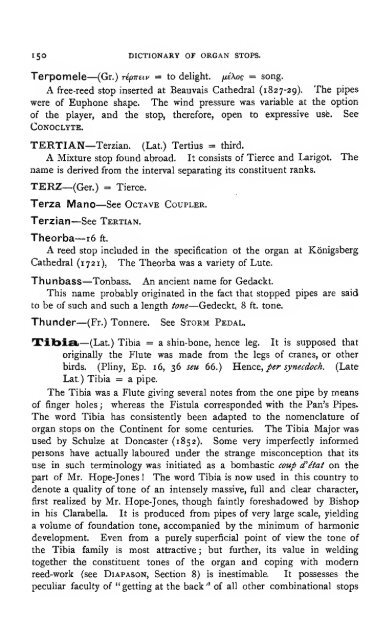A comprehensive dictionary of organ stops - Allen Organ Studio of ...
A comprehensive dictionary of organ stops - Allen Organ Studio of ...
A comprehensive dictionary of organ stops - Allen Organ Studio of ...
You also want an ePaper? Increase the reach of your titles
YUMPU automatically turns print PDFs into web optimized ePapers that Google loves.
ISO DICTIONARY OF ORGAN STOPS.<br />
Terpomele—(Gr.) ripwuv = to delight. fisXoe = song.<br />
A free-reed stop inserted at Beauvais Cathedral (1827-29). The pipes<br />
were <strong>of</strong> Euphone shape. The wind pressure was variable at the option<br />
<strong>of</strong> the player, and the stop, therefore, open to expressive use. See<br />
Conoclyte.<br />
TERTIAN—Terzian. (Lat.) Tertius = third.<br />
A Mixture stop found abroad. It consists <strong>of</strong> Tierce and Larigot. The<br />
name is derived from the interval separating its constituent ranks.<br />
TERZ—(Ger.) = Tierce.<br />
Terza Mano—See Octave Coupler.<br />
Terzian—See Tertian.<br />
Theorba— 16 ft.<br />
A reed stop included in the specification ot the <strong>organ</strong> at Konigsberg<br />
Cathedral (1721), The Theorba was a variety <strong>of</strong> Lute.<br />
Thunbass—Tonbass. An ancient name for Gedackt.<br />
This name probably originated in the fact that stopped pipes are said<br />
to be <strong>of</strong> such and such a length tone—Gedeckt, 8 ft. tone.<br />
Thunder—(Fr.) Tonnere. See Storm Pedal.<br />
Tibia,—(Lat.) Tibia = a shin-bone, hence leg. It is supposed that<br />
originally the Flute was made from the legs <strong>of</strong> cranes, or other<br />
birds. (Pliny, Ep. 16, 36 seu 66.) Hence, per synecdoch. (Late<br />
Lat.) Tibia = a pipe.<br />
The Tibia was a Flute giving several notes from the one pipe by means<br />
<strong>of</strong> finger holes ; whereas the Fistula corresponded with the Pan's Pipes.<br />
The word Tibia has consistently been adapted to the nomenclature <strong>of</strong><br />
<strong>organ</strong> <strong>stops</strong> on the Continent for some centuries. The Tibia Major was<br />
used by Schulze at Doncaster (1852). Some very imperfectly informed<br />
peisons have actually laboured under the strange misconception that its<br />
use in such terminology was initiated as a bombastic coup tTe'tat on the<br />
part <strong>of</strong> Mr. Hope-Jones ! The<br />
word Tibia is now used in this country to<br />
denote a quality <strong>of</strong> tone <strong>of</strong> an intensely massive, full and clear character,<br />
first realized by Mr. Hope-Jones, though faintly foreshadowed by Bishop<br />
in his Clarabella. It is produced from pipes <strong>of</strong> very large scale, yielding<br />
a volume <strong>of</strong> foundation tone, accompanied by the minimum <strong>of</strong> harmonic<br />
development. Even from a purely superficial point <strong>of</strong> view the tone <strong>of</strong><br />
the Tibia family is most attractive ; but further, its value in welding<br />
together the constituent tones <strong>of</strong> the <strong>organ</strong> and coping with modern<br />
reed-work (see Diapason, Section 8) is inestimable. It possesses the<br />
peculiar faculty <strong>of</strong> "getting at the back" <strong>of</strong> all other combinational <strong>stops</strong>


